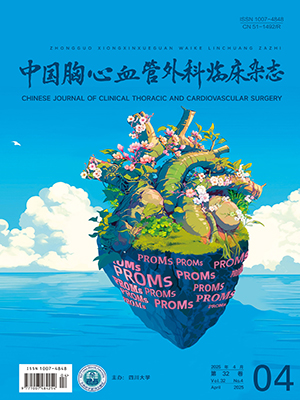| 1. |
徐善祥, 王连, 杨俭新, 等.ICU中创伤性凝血病的影响因素与临床意义.中华急诊医学杂志, 2012, 21 (9):1007-1011.
|
| 2. |
蒋国平, 雷李美, 文怀, 等.参附注射液对多发伤并发休克患者凝血功能的影响.中华急诊医学杂志, 2012, 21 (10):1127-1129.
|
| 3. |
徐少文, 赵小纲, 张茂.严重创伤救治若干新进展.中华急诊医学杂志, 2011, 20 (5):456-458.
|
| 4. |
邓秋明, 尚东, 万献尧.小剂量激素对感染性休克患者凝血功能的影响.中国危重病急救医学, 2011, 23 (3):183-184.
|
| 5. |
赵鹤龄, 任珊, 申丽旻.辛伐他汀预处理对脓毒症大鼠凝血功能及肝脏C-反应蛋白的影响.中国急救医学, 2012, 32 (8):718-721.
|
| 6. |
王正国.创伤研究进展.中华急诊医学杂志, 2012, 21 (6):565-567.
|
| 7. |
张志强, 陈晓丽, 卢云锋.银杏叶提取物治疗重症急性胰腺炎的疗效分析.中华急诊医学杂志, 2012, 21 (8):878-882.
|
| 8. |
梁英健, 马晓春, 李鑫, 等.p38MAPK/NF-κB转导通路在脓毒症所致内皮细胞凝血功能障碍中的作用.中国危重病急救医学, 2010, 22 (9):528-532.
|
| 9. |
张育才, 左文琼, 龚小慧, 等.内毒素性休克大鼠肺组织糖皮质激素受体mRNA的表达.中华急诊医学杂志, 2010, 19 (2):136-139.
|
| 10. |
汪宗昱, 吴胜楠, 朱曦.3种剂量普通肝素雾化吸入对内毒素致肺损伤大鼠肺泡凝血和组织炎症损伤的效应比较.中国危重病急救医学, 2012, 24 (10):612-615.
|
| 11. |
张亚男, 张艳芬, 辛晓敏.大鼠DIC时脑细胞水通道蛋白-4的表达及意义.中国急救医学, 2012, 32 (5):430-433.
|
| 12. |
毛怡然, 肇冬梅, 马晓春.肝素对脂多糖诱导内皮细胞通透性增高的保护作用.中国危重病急救医学, 2012, 24 (5):278-282.
|
| 13. |
浦江, 崔立红, 刘超群, 等.黄体酮对腹部开放性海水浸泡大鼠肠道黏膜的保护作用研究.中国急救医学, 2012, 32 (7):635-638.
|
| 14. |
武永胜, 李得溪, 赵海平.胰性脑病的发病机制.中华急诊医学杂志, 2011, 20 (1):105-108.
|
| 15. |
王丽杰, 舒林华, 许玲芬, 等.银杏苦内酯B对内毒素血症幼鼠肠道的保护作用.中华急诊医学杂志, 2008, 17 (4):380-384.
|
| 16. |
高红梅, 王兵, 李寅, 等.重组人血小板生成素治疗脓毒症血小板减少症.中华急诊医学杂志, 2011, 20 (3):239-243.
|
| 17. |
苏嫒, 董泽华, 付培荣, 等.血必净注射液对严重脓毒症患者血小板参数及凝血功能的影响.中国急救医学, 2011, 31 (7):599-601.
|
| 18. |
卞秋武, 林海龙, 张双月, 等.替罗非班联合瑞替普酶治疗急性心肌梗死的有效性及完全性研究.中国急救医学, 2012, 32 (9):786-789.
|
| 19. |
孙振朕, 朱科明, 邓小明.血小板和中性粒细胞在脓毒症中作用机制的研究进展.中国危重病急救医学, 2011, 23 (8):502-504.
|
| 20. |
齐洛生, 杨宏富, 孙荣青, 等.严重外伤患者的凝血功能变化.中国危重病急救医学, 2010, 22 (6):379-380.
|
| 21. |
王兵, 王勇强, 曹书华, 等.脓毒症患者血小板参数与Toll样受体4表达的关系及中西医结合治疗研究.中国危重病急救医学, 2011, 23 (10):616-620.
|
| 22. |
苏俊, 王锦权, 陶晓根, 等.毛细血管渗漏综合征的易患因素分析.中国急救医学, 2011, 31 (10):872-875.
|
| 23. |
王兵, 王勇强, 邵蕾, 等.血小板对TLR4表达及活化在脂多糖诱发小鼠血小板减少中的作用.中华急诊医学杂志, 2011, 20 (12):1290-1294.
|
| 24. |
喻莉, 龙鼎, 武晓灵, 等.全身炎症反应综合征中血浆尿激酶型纤溶酶原激活物及其受体的表达.中华急诊医学杂志, 2011, 20 (10):1079-1083.
|
| 25. |
施小燕.颅脑外伤后继发性脑损伤的防治.中华急诊医学杂志, 2011, 20 (12):1237-1239.
|
| 26. |
苏俊, 王锦权.毛细血管渗漏综合征的研究进展.中华急诊医学杂志, 2011, 20 (5):546-548.
|




